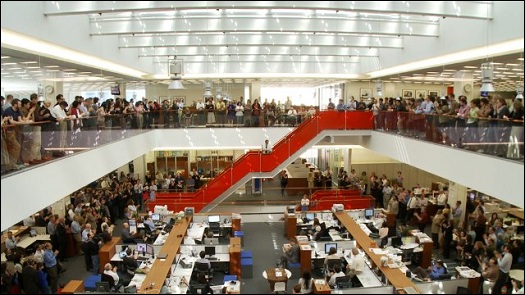A Valentine to an Embattled Paper
A Valentine to an Embattled Paper
L. Quart: An Embattled Paper
Inside the New York Times
a documentary directed by Andrew Rossi
I HAVE been a faithful daily reader of the New York Times for close to five decades. I subscribe to a number of magazines, listen every morning to NPR, and watch MSNBC’s repetitive, often entertaining, and sometimes penetrating takes on the political process, but none of these media offer the type of coverage that the Times provides. It remains my prime conduit for hard news, political analysis, and stories about neighborhood life and local developments. Despite lacunas in its reporting of international news (though it does it better than any of its competitors), and a Sunday Magazine that is dominated by pedestrian writing and filler, in recent years its cultural coverage has become more extensive and increasingly sophisticated and open.
But newspapers, even the Times, are clearly threatened by the emergence of online publications like the Huffington Post, which have driven down subscription numbers and advertising dollars. Many newspapers have gone bankrupt and shut down, and others have closed news bureaus and radically cut their staffs. There are now multiple voices in the marketplace, and the new digital media are a genuine challenge to traditional ones like the Times. In 1969 Gay Talese’s The Kingdom and the Power immortalized the New York Times as an imperial institution whose mission went far beyond the mere reporting of facts. He was critical of the paper, but felt that “nobody tells the truth as much as the Times tries to tell the truth,” and that we would be bereft without it.
Andrew Rossi’s documentary Page One: Inside the New York Times finds that august publication in a far more wobbly condition. The film is set in 2009-2010, at a time when the Times began to give out pink slips to long-time editors and staff members and saw its advertising revenue fall precipitously, while other periodicals published articles speculating that the Times’ demise might be mere months away. Rossi’s film makes use of commentary—by such incisive journalistic luminaries as the New Yorker’s David Remnick, the Nation’s Katrina van den Heuvel, and the Huffington Post’s aggressively entrepreneurial Arianna Huffington—on the plight of traditional news sources and what the effect of their disappearance would be. However, the film is not dominated by talking heads. It’s essentially a cinéma vérité exploration of the Times’ journalists assiduously at work.
The film contains a fragmented narrative centering on the role of the paper’s media desk—which reports on the radical changes occurring in mass communications, and the paper’s role in those changes—and the desk’s charismatic star columnist, David Carr. Rossi had unprecedented access to the newsroom, spending fourteen months inside the Times’ new steel-framed and glass-walled headquarters in midtown Manhattan. He observes Carr moving among fellow Times journalists, pursuing stories like the case of sexual harassment at the Chicago Tribune (which eventually led to a shakeup of that paper’s management), and passionately defending the paper when attacked by its critics at media events.

In fact, the film was initially supposed to be just about Carr, but when Carr felt he couldn’t do his job while having a cameraman trailing him at all times, he suggested that Rossi create a more expansive portrait of the paper. But the idiosyncratic, profane, professional, and articulate Carr is still the film’s star, and clearly Rossi’s favorite Times journalist.
Carr came to the Times as a veteran of the alternative newsweekly scene and a former crack addict and single father on welfare, as he recounted in an unsparing memoir. Carr wears his bio too self-consciously in the film, but his tale is not just a sensational story, since it does partly explain his commitment to the Times. The job has clearly helped sustain his personal transformation, and he has tuned into the most loyal of Times men.
There are other media desk reporters like Tim Arango—a young Iraq-bound reporter—who are given more than cursory film time, but among these men (the two women on the media desk declined to appear), none but Carr leaves a mark. Other sections of the newspaper are left untouched. Yet while the film centers on one small section of the paper, at the same time it takes on too much: the Times’ scandals, like Judith Miller’s blind and unquestioning reporting of non-existent WMDs and Jayson Blair’s plagiarized and fabricated stories; Comcast’s purchase of NBC; and a great many details about WikiLeaks and the Julian Assange agenda. All of these are significant stories that reveal much about the Times and the state of contemporary journalism, but need to be extended to do them justice.
In spite of Page One’s somewhat disjointed quality, it succeeds in providing a vivid and extremely positive (possibly too positive) view of the workings of the Times. Its journalists are smart, dedicated, skilled, and ferociously competitive. Page One makes us feel that despite being embattled, the Times has the tenacity and talent to survive. Bill Keller, the Times’ former executive editor, has the film’s last words: Addressing the paper’s staff, he states “that journalism is alive, well, and feisty, especially at the New York Times.” And I for one say amen.
Leonard Quart is the coauthor of the fourth edition of American Film and Society Since 1945 and is a contributing editor of Cineaste.
Photo: Inside the New York Times‘ headquarters in New York






